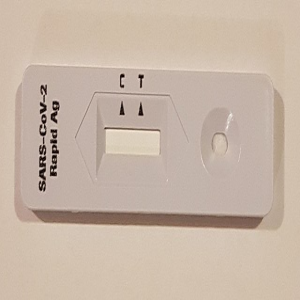Passengers screening for SARS-CoV-2 infection at Rome Fiumicino Airport: a strategy aimed at limiting the spreading of the infection through COVID-free air flights revealed the airport role as a formidable sentinel center for monitoring pandemic trends and viral variants circulation

HTML: 21
All claims expressed in this article are solely those of the authors and do not necessarily represent those of their affiliated organizations, or those of the publisher, the editors and the reviewers. Any product that may be evaluated in this article or claim that may be made by its manufacturer is not guaranteed or endorsed by the publisher.
Background and aims: At the Fiumicino Rome Airport, passengers can undergo the antigen or molecular test for SARS-CoV-2 at the COVID-19 Test Area (CTA), in compliance with the boarding regulations on air flights and those for entering the destination countries. The aim of this study was to describe the adaptability and usefulness of using rapid molecular tests designed for point of care (POC) in a context such as the CTA of Rome Fiumicino airport, by describing the volume and activities performed in the last period of the state of emergency in Italy, July 10, 2021- March 31, 2022.
Materials and methods: Rapid molecular tests for SARS-CoV-2 were carried out with ID NOWTM COVID-19 assay on the ID NOWTM platform using dry swabs collected from passengers (or airport staff) at the CTA. Swabs were stored at room temperature and analyzed within 1-2 hours of collection. Sequencing for SARS-CoV-2 variants of concern (VOC) identification was carried out on swabs dipped in universal transport medium (UTM), after new swab gathering from consenting passengers resulted positive with the rapid molecular assay. A proficiency panel prepared with the viral isolate 2019-nCoV/Italy INMI1 was used to evaluate analytical sensitivity; clinical sensitivity was tested by performing real-time polymerase chain reaction (RT-PCR) tests on 50 swabs obtained from passengers who previously resulted positive to ID NOWTM COVID-19 assay.
Results: In total, 14632 rapid molecular tests for SARS-CoV-2 were performed at CTA and 5.6% resulted positive. Sequence analysis of samples with Ct value <25 (61,2 %) with real-time RT-PCR test allowed detection of all the main VOCs: B.1.617.2 (Delta) in 18% of samples, BA.1 (Omicron-1) in 34% of positive swabs and BA.2 (Omicron-2) lineage in 9% of samples. The BA.2 variant was detected in the Lazio region for the first time at CTA, in one sample obtained from an Italian passenger coming from Doha, Qatar. A proficiency panel for SARS-CoV-2 detection was used to establish the limit of detection of ID NOWTM COVID-19 assay. For clinical sensitivity evaluation, 50 subjects with positive results by ID NOWTM COVID-19 assay were tested with routine real-time RT-PCR method in the laboratory and confirmed for SARS-CoV-2 detection.
Conclusions: The great success among passengers, demonstrated by the large number of rapid molecular tests performed, confirmed the appreciation of this service by the users. Our experience at CTA showed that airports, railways and maritime stations should represent strategic surveillance centers for monitoring of circulation of respiratory pathogens, and may have a direct impact on the implementation of prevention and control strategies for public health against the spreading of infectious diseases. Indeed, SARS-CoV-2 data obtained at the CTA faithfully reflected the Italian epidemic curve trend of SARS-CoV-2 and its variants. The rapid molecular ID NOWTM COVID-19 assay used at CTA has proven to be suitable for use in a special context, such as the Rome Fiumicino Airport, though it was designed for use in POC. Due to the simplicity of use, robustness of method and technology that allows the return of results in a few minutes, this system revealed itself to be an optimal tool at the CTA, ensuring passengers boarding on COVID-free flights in a short time and security.
Abbott Rapid Diagnostics, Charlottesville, USA. Available at: https://www.globalpointofcare.abbott/it/lp/covid-19.html
Colavita F, Lapa D, Carletti F, et al. Virological characterization of the first 2 COVID-19 patients diagnosed in Italy: phylogenetic analysis, virus shedding profile from different body sites, and antibody response kinetics. Open Forum Infect Dis. 2020;7:ofaa403.
Curtis KA, Niedzwiedz PL, Youngpairoj AS, et al. Real-time detection of HIV-2 by reverse transcription–loop-mediated isothermal amplification. Journal of Clinical Microbiology 2014;52:2674-6. DOI: https://doi.org/10.1128/JCM.00935-14
European Commission Joint Researc Center. Certified reference materials catalogue. Available at: https://crm.jrc.ec.europa.eu/p/EURM-019
Huang WE, Lim B, Hsu CC, et al. RT‐LAMP for rapid diagnosis of coronavirus SARS‐CoV‐2. Microbial Biotechnology 2020;13:950-961. DOI: https://doi.org/10.1111/1751-7915.13586
Neeraja M, Lakshmi V, Vanjari Lavanya, et al. Rapid detection and differentiation of dengue virus serotypes by NS1 specific reverse transcription loop-mediated isothermal amplification (RT-LAMP) assay in patients presenting to a tertiary care hospital in Hyderabad, India. Journal of Virological Methods 2015;211:22-31. DOI: https://doi.org/10.1016/j.jviromet.2014.10.005
Zhuang L, Gong J, Li Q, et al. Detection of Salmonella spp. by a loop‐mediated isothermal amplification (LAMP) method targeting bcfD gene. Letters in Applied Microbiology 2014;59:658-64. DOI: https://doi.org/10.1111/lam.12328
Supporting Agencies
NonePAGEPress has chosen to apply the Creative Commons Attribution NonCommercial 4.0 International License (CC BY-NC 4.0) to all manuscripts to be published.


 https://doi.org/10.4081/mm.2022.10682
https://doi.org/10.4081/mm.2022.10682



